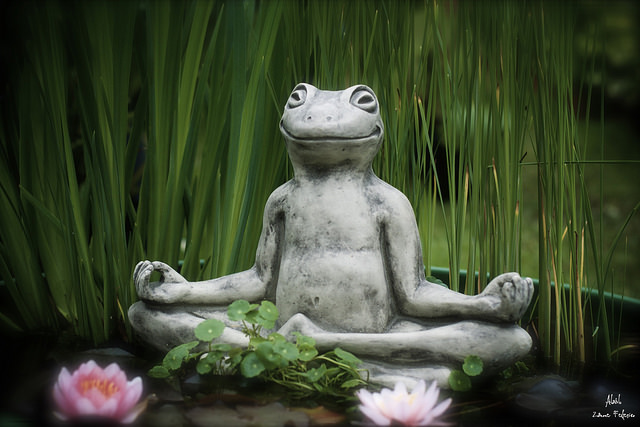
What is Zen? This is not such an easy question to answer with words. A traditional Zen master might respond with a shake of the head or by hurling a non-lethal object at the asker.
Zen is a sincere connection with the flow of life. Zen is a concentration on whatever we are doing. “[Zen] practice is the direct expression of our true nature,” said one master.
In Zen, there is no faraway enlightenment. There are no gods and no goals. Zen is, in my view, just a clever way of living. Whatever we are doing—as long as our mind is fully engaged with the task—can be Zen. Even doing nothing can be Zen. This does not mean, however, that there is nothing to be done.
All we experience—past, present, and future—is filtered through our minds. Because of this, we should probably train them. Zen practice is, essentially, a mind exercise. As with any training regimen, we need someone to show us the way. We need a master.
The Zen master in question is not Phil Jackson. (Sorry NBA fans). This guru predates Phil by about 30 years. Shunryu Suzuki came to San Francisco in 1958, set up the Zen Center, and taught until his death in 1971. His favorite animal—one he believed epitomized Zen practice—was the patient frog, waiting motionless for an insect. The quotes below are from Zen Mind, Beginner’s Mind, a compilation of Suzuki’s talks:
Lesson 1: “When you feel disagreeable it is better for you to sit. There is no other way to accept your problem and work on it.”
A few months ago, I missed my plane. The word came 10 minutes too late. I had been sitting at the wrong gate—a gate with open seats—and didn’t hear the attendant announce my name for a flight change. Rushing to the airline desk, I explained my misfortune to a middle-aged guy without hair. “No more flights today,” he snorted, looking mildly bored. I swallowed a mouthful of saliva.
Waiting for my ride home, I concluded that I was, in fact, the most incompetent traveler alive. How could I be such an imbecile?
But soon, my intense self-flagellation provoked a moment of mindfulness. I straightened my posture, closed my eyes, and opened my awareness. I let everything in. It was miserable at first, but after a few minutes of acceptance, the incident lost its sting. And by the time I got home, I was chuckling about it. Suzuki is right—this is how to work through problems.
Lesson 1 Practice: Zen meditation emphasizes proper posture and breathing. You should sit still with a straight back and focus gently on the breath. This doesn’t mean thoughts should be ignored. Rather, thoughts should be noticed as thoughts. In this way, problems—a side effect of thinking—can be understood and diffused.
Lesson 2: “Without accepting the fact that everything changes, we cannot find perfect composure. But unfortunately, although it is true, it is difficult for us to accept it. Because we cannot accept the truth of transiency, we suffer.”
Everything changes. No truth is more fundamental. Yet, as Suzuki said, we don’t accept it. We identify very strongly, for example, with our body. We lock eyes in the mirror each morning—that’s me. We fix our appearance in our minds. And when it changes, we suffer. A receding hairline is a crisis. A facial blemish is a personal insult.
Yet most of our body is left out of this calculus. We don’t—with the exception of a splenectomy patient—identify with our spleens. (For all I know, I don’t even have one.) External appearances, however, are taken as “me.” This is absurd.
The contents of our minds are also in perpetual flux. Every appearance in consciousness simply comes and goes. When this is understood, we are less likely to be swirled away by a torrent of thoughts and emotions. The chain is broken. We can settle back and watch the passing show.
Lesson 2 Practice: To connect with impermanence, simply watch your thoughts. In meditation, or throughout the day, notice how thoughts arise and disappear. This level of attention brings with it a sense of lightness. After all, thoughts only have power because they seem permanent.
Lesson 3: “Whatever you do, it should be an expression of the same deep activity. We should appreciate what we are doing. There is no preparation for something else”
This is the heart of Zen teaching. When we cook, we just cook. When we sit, we just sit. When we listen to a blowhard colleague talk politics, we just listen. We do things with a single mind.
This sounds simple, but it’s not.
In this tech-infused culture, our attention is yanked around like a kite in a hurricane. Our senses are bombarded with pictures, emails, texts, websites, articles and sound-bites from dawn til dusk. There is a sense we must know it all. Every update from the office. Every political scandal. Every hangover suffered by a Facebook friend living in San Francisco. You might call this un-training the mind.
But we can overcome this scattered-attention, multi-tab conditioning. We can teach our minds to be still in crisis. There may be nothing special about Zen—no fancy shtick—yet its effect on our lives can be profound.
Lesson 3 Practice: Throughout the day, make an effort to do things with a single mind. If you’re eating breakfast, just taste and chew the food. If you’re listening to a friend, don’t think of your next contribution—just listen. If you’re working on a presentation, give that your full attention. Not only will you feel calmer, you’ll be more productive.
~
Author: Brian Stanton
Editor: Travis May
Image: Flickr/Frederico Zanone


 Share on bsky
Share on bsky




Read 1 comment and reply